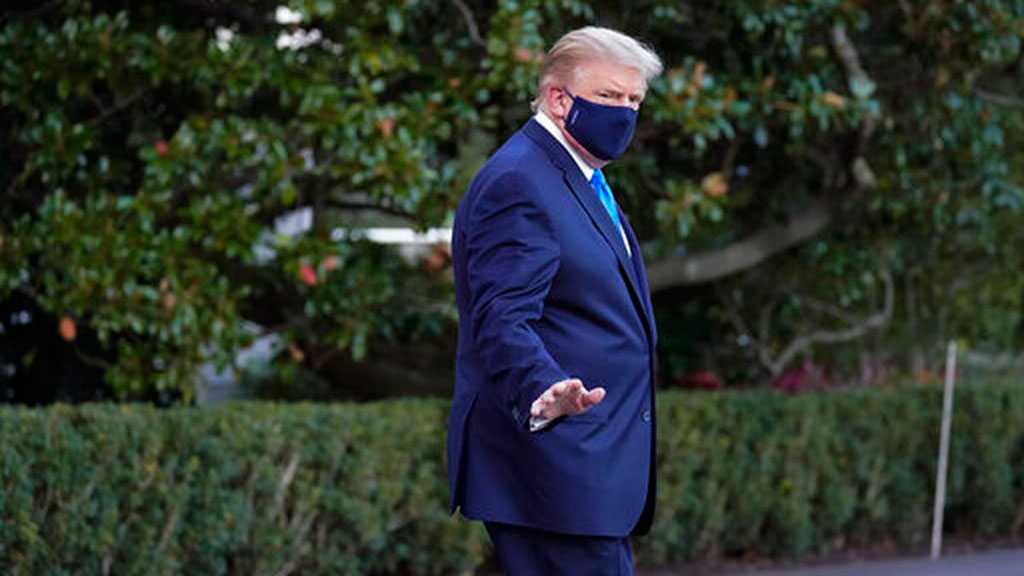
Trump Leaves Hospital Briefly ‘To Greet Supporters Outside’

By Staff, Agencies
US President Donald Trump declared, "I get it," in a message to the nation Sunday evening before briefly leaving the hospital to greet cheering supporters from his motorcade, a surprising move that suggested that his health - and his understanding of the coronavirus - may be improving.
Hours earlier, Trump’s medical team confirmed that his blood oxygen level dropped suddenly twice in recent days. But they also said he could be discharged as early as Monday.
"It’s been a very interesting journey. I learned a lot about COVID," Trump said, standing in his hospital room in a video posted on social media. "I learned it by really going to school."
He added, "I get it, and I understand it."
At least one medical professional inside Walter Reed National Military Medical Center, where Trump has been hospitalized since Friday evening, questioned whether Trump had really learned anything.
"Every single person in the vehicle during that completely unnecessary presidential ‘drive-by’ just now has to be quarantined for 14 days. They might get sick. They may die. For political theater. Commanded by Trump to put their lives at risk for theater. This is insanity," Dr. James P. Phillips, an attending physician at Walter Reed, tweeted.
Earlier in the day, Trump's doctors revealed they gave the president a steroid treatment typically only recommended for the very sick. But they sidestepped questions about exactly when Trump’s blood oxygen dropped - an episode they neglected to mention in multiple statements the day before - or whether lung scans showed any damage.
It was the second straight day of confusion and obfuscation from a White House already suffering from a credibility crisis. And it raised questions about whether the doctors treating the president were sharing accurate, timely information with the American public about the severity of him condition.
Pressed about conflicting information he and the White House released on Saturday, Navy Cmdr. Dr. Sean Conley acknowledged that he had tried to present a rosy description of the president’s condition.
"I was trying to reflect the upbeat attitude of the team, that the president, that his course of illness has had. Didn’t want to give any information that might steer the course of illness in another direction," Conley said. "And in doing so, came off like we’re trying to hide something, which wasn’t necessarily true. The fact of the matter is that he’s doing really well."
The briefing outside the Walter Reed National Military Medical Center lasted just 10 minutes.
Medical experts said Conley’s revelations raised new questions about how ill the president was and are hard to square with the doctor’s upbeat assessment and talk of a discharge.
"There’s a little bit of a disconnect," said Dr. Steven Shapiro, chief medical and scientific officer at the University of Pittsburgh Medical Center.
Blood oxygen saturation is a key health marker for COVID-19 patients. A normal reading is between 95 and 100. Conley said the president had a "high fever" and a blood oxygen level below 94% on Friday and during "another episode" on Saturday.
He was evasive about the timing of Trump oxygen drops. ["It was over the course of the day, yeah, yesterday morning," he said] and asked whether Trump’s level had dropped below 90%, into concerning territory. ["We don’t have any recordings here on that."] But he revealed that Trump was given a dose of the steroid dexamethasone in response.
At the time of the briefing, Trump’s blood oxygen level was 98% - within normal rage, Trump’s medical team said.
Signs of pneumonia or other lung damage could be detected in scans before a patient feels short of breath, but the president’s doctors declined to say what those scans have revealed.
"There’s some expected findings, but nothing of any major clinical concern," Conley said. He declined to outline those "expected findings."
Asked about Conley’s lack of transparency, White House aide Alyssa Farah suggested the doctors were speaking as much to the president as to the American public, "when you’re treating a patient, you want to project confidence, you want to lift their spirits and that was the intent."
Comments



